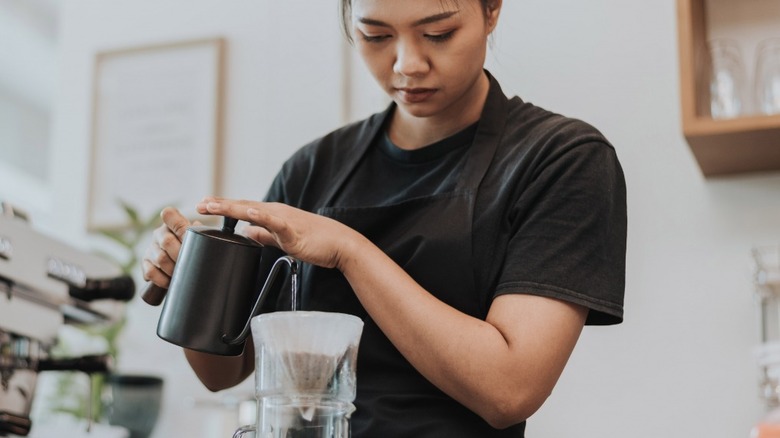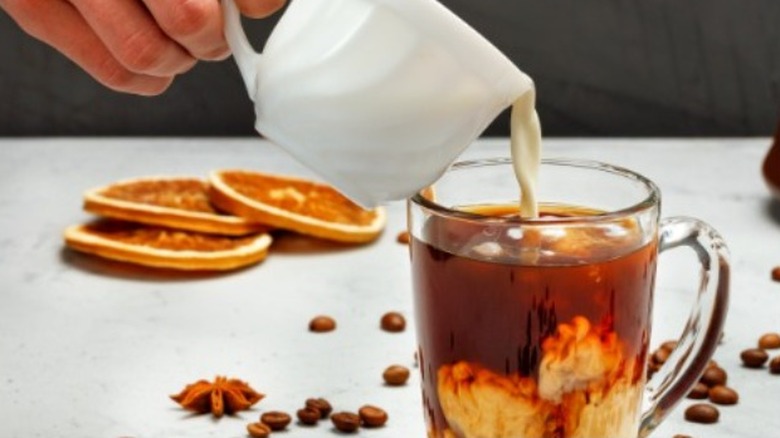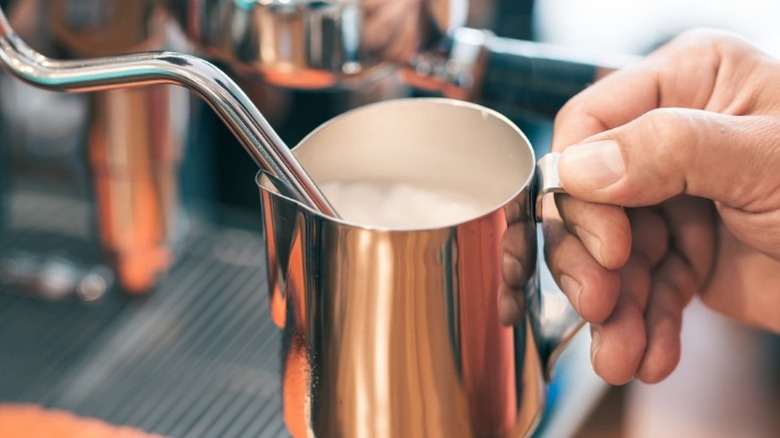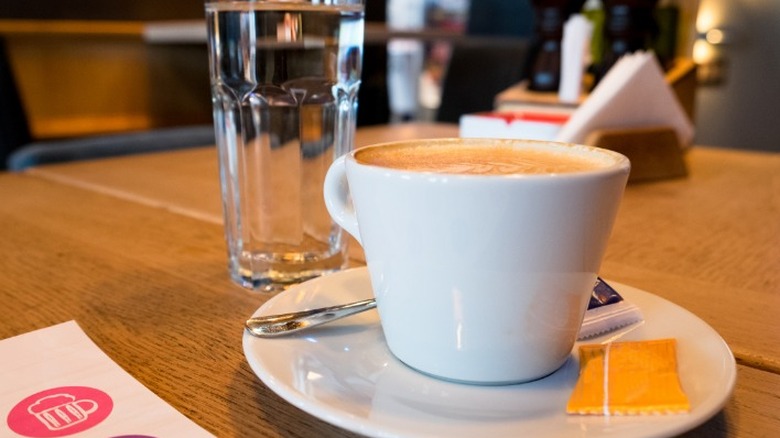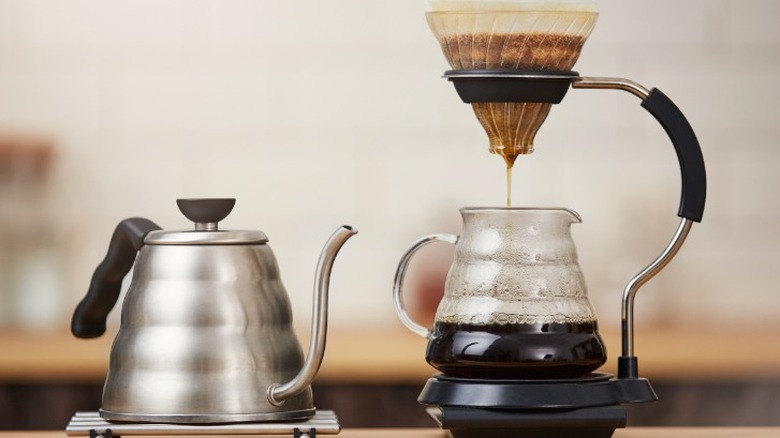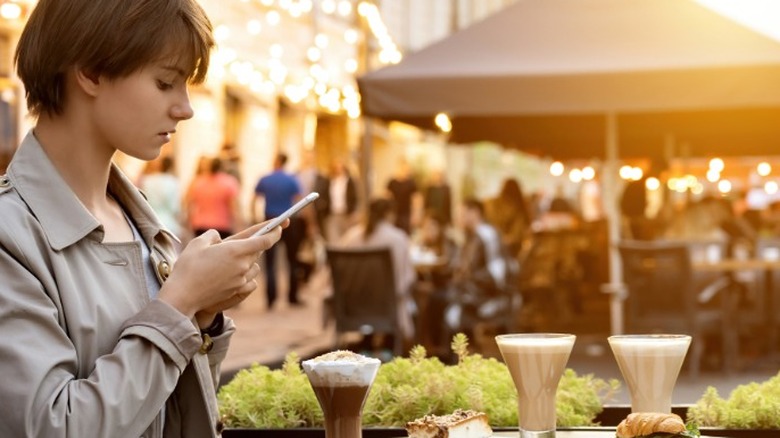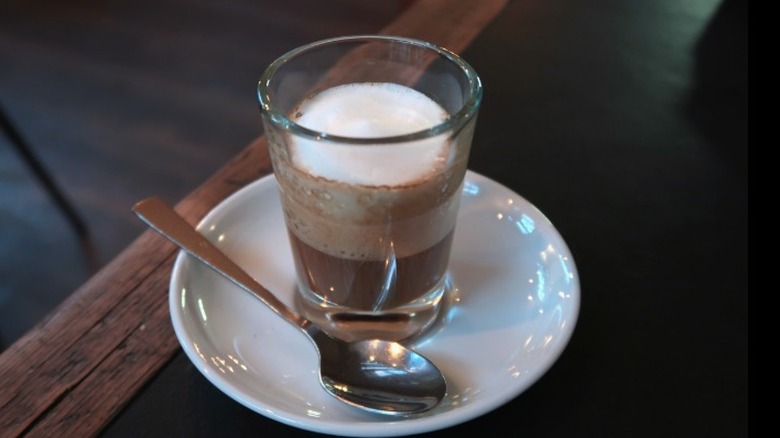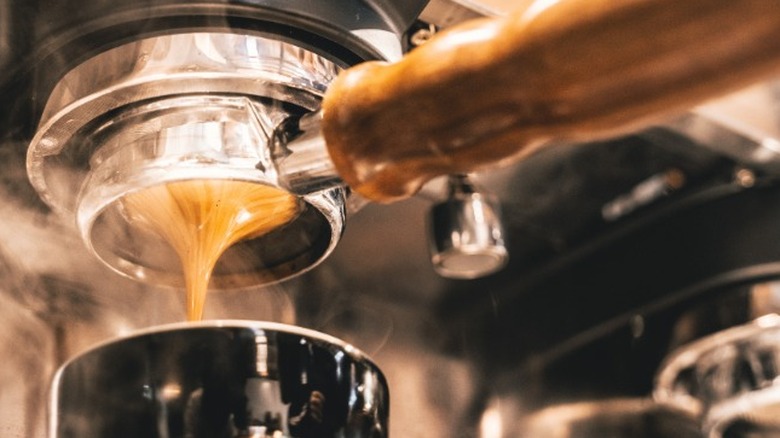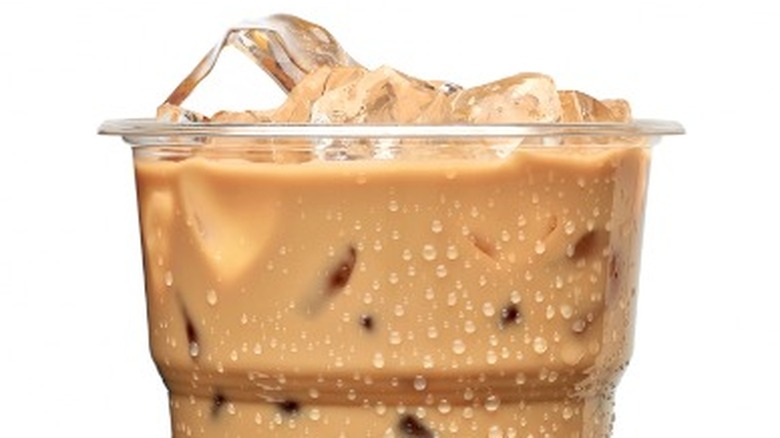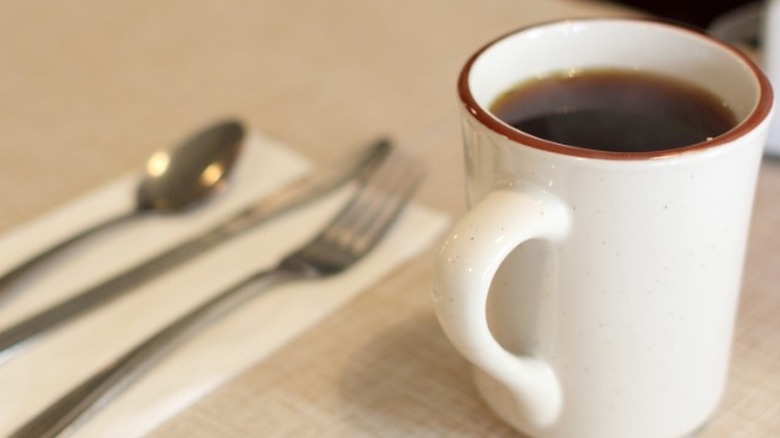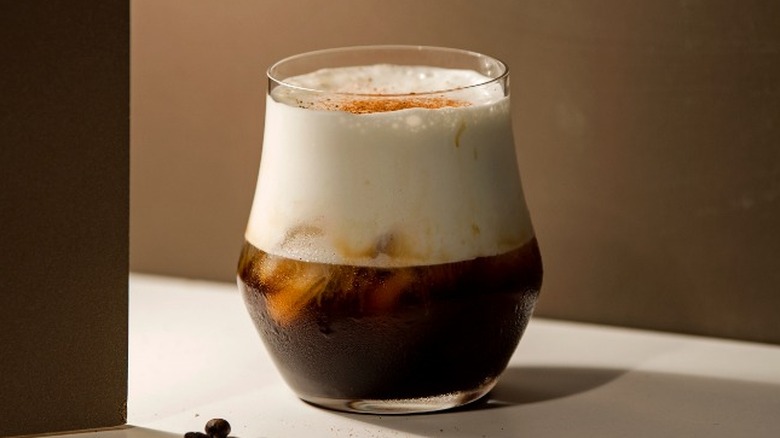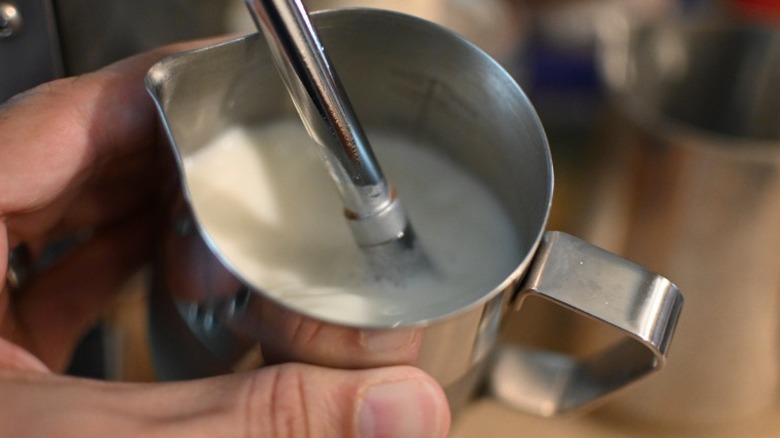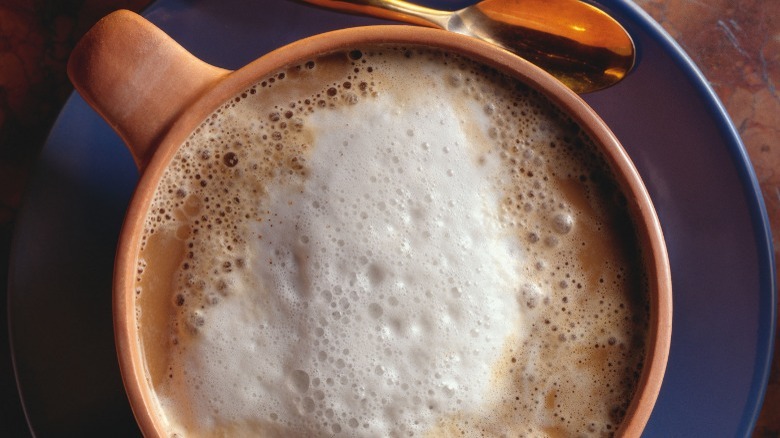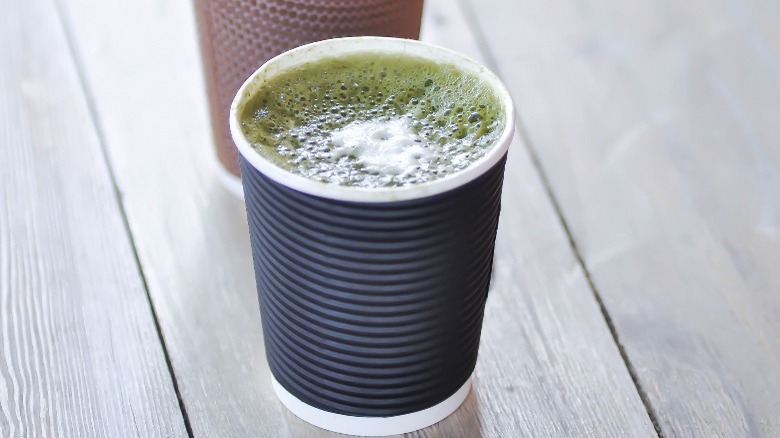13 Drinks That Are Red Flags For Your Coffee Barista
Baristas are typically a cheerful, chipper bunch. How else could they muster the energy to talk to a bunch of people in the early morning hours on a regular basis? Seriously, caffeine can only get you so far. But anyone who's worked a service industry job — or had an honest conversation with someone who does — knows that these coffee whizzes are calculating more than just espresso shots when they're behind the counter. Most of them are judging you ... just a little bit, on the drink that you order.
It's generally harmless, the same way you might judge someone for putting ketchup all over their eggs at the diner or for dipping their French fries in a milkshake. But, inevitably, there are a few red flags that baristas notice after spending enough time in the field. Keep on reading for eleven faux pas to be aware of next time you're ordering a coffee.
1. Ordering a drink with heavy cream
If you're ordering heavy cream in your coffee, you should probably ask yourself: do you actually just want a milkshake? Or a vat of java-flavored ice cream? Even a few tablespoons of heavy cream is enough to drown out the integrity of a cup of coffee. And baristas on Reddit have shared that some customers go far beyond that, ordering a whole latte's worth of heavy cream.
This unsettling coffee decorum has been embraced by the keto community as a low-carb, high-fat meal substitute that helps the body reach a state of fat-burning "ketosis." But with 51 calories in every tablespoon of heavy cream, a whole latte (which is essentially just an espresso shot with a cup or two of milk) could fall between 800-1,600 calories. We're not the type to count calories, but that sounds extreme for a morning cup of "joe."
Beyond the questionable flavor and health benefits of such a drink, it can also be a hassle for baristas to assemble, since they usually don't keep heavy cream on hand for lattes. "It's usually used in making something not a latte and requires finding as well as opening and dating," says Dale Donchey, a barista and owner of the Atlanta-based Spiller Park Coffee.
2. It's even more problematic when asking for a hot heavy cream drink
If you're requesting that heavy cream latte as a hot drink, you're putting your barista in an even more irksome position. "Steaming silky, luscious microfoam requires a precise ratio of fat, protein and water, of which whole milk has the best," explains Jiyoon Han, a Q grader, barista, and co-owner of New York City's Bean & Bean Coffee. "Heavy cream simply has too much fat, which tends to cause the foam to collapse and separate."
There's also the issue of "screaming milk," which Donchey describes as the sound of a "banshee being screamed at by a banshee." Basically, this phenomenon happens for two reasons: when the milk isn't being aerated properly, or when the liquid is simply so dense that air is unable to escape, in the case of heavy cream, eggnog, etc.
A true pro will be able to successfully steam heavy cream, but it's certainly not an easy feat. That's a lot to put your barista through just so you can enjoy a weirdly-hot coffee milkshake.
3. Ordering a cappuccino without foam
Is there any good reason for ordering this? According to Donchey, the answer is no. "Get an au lait," he recommends. "Cappuccinos are sacred." What Donchey means is that foam is a make-or-break element of a cappuccino. Made with equal parts espresso, steamed milk, and foam, the cappuccino is designed to envelope its milky, espresso base with a cloudlike topping of froth.
Han echoes this. "When made correctly, the microfoam in a latte or cappuccino adds a textural dimension that's otherwise missing," she explains. "I also find that microfoam helps to carry and enhance the coffee flavor, making it sweeter and more rounded. A latte or cappuccino with no foam would just be coffee and hot milk — not as exciting, in my opinion."
Moreover, without the foam, a cup of cap will look sadly empty. A cappuccino generally contains one-third less steamed milk than a latte and two-thirds less than a flat white, making the decision to exempt foam a pretty odd one.
Redditor sprobebeforebros sums it up well, saying, "no foam doesn't raise so much of a red flag for me as [it] makes me think 'who hurt you?'"
4. Adding milk or cream to a pour-over
Pour-over is arguably the best way to taste the full spectrum of flavor in your coffee, especially if you're lucky enough to have a quality bag of single-origin beans. The pour-over method allows the brewer to extract the coffee's best flavors while downplaying the more bitter aspects, resulting in a silkier, more gentle cup of java. But like all good things, this process takes time, craft, and precision.
Due to the sheer number of steps — from measuring beans and nailing the bloom to weighing the water — Han considers pour-over one of the hardest drinks to pull off consistently. "There are a lot more steps that go into preparing a pour-over than an espresso-based drink—meaning many more chances for error—and making a mistake often means having to start over," she explains.
The result of this painstaking process? Coffee that is silky smooth, less bitter, and far more flavorful. That's all good and fine, but if you're going to cover all that up in a blanket of milk, why put your barista through all of that? Especially if there's a line behind you, just order a drip.
5. A drink order you saw on TikTok that's not actually on the menu
You may love learning about trending drinks on TikTok, but many baristas don't share the same zeal. Especially when the coffee drinks in question are convoluted and, frankly, taste bad. An extreme example of this was a drink that was highlighted on TikTok called "The Edward." It involved 13 changes from the standard Starbucks recipe, including gobs of extra caramel, ice, cinnamon dolce topping, and (*sigh*) heavy cream. Small tweaks here and there make sense, but ask yourself: would you order a dish that's not on the menu at a restaurant? So why would you do that at a cafe?
Granted, some baristas have shared that they're willing to make simpler items, like the Starbucks' White Chocolate Mocha with two pumps of raspberry syrup — but as a basic guideline, we recommend asking your barista if they're comfortable and aren't too slammed, before ordering something strange. You should have the same etiquette in this situation as you would when considering whether or not to ask a bartender to make you a gin fizz.
To his credit, Donchey says he is happy to attempt to make your TikTok drink ... with one major caveat: "As long as I got the ingredients, you fully understand that I don't think you should go forward with the order ... and you're willing to pay the dumb amount I'm going to make up as a price; bring it on." He adds, "just don't forget to tip."
6. Ordering a macchiato when you really mean latte
Word to the wise: there's a major difference between the iced caramel macchiato that Starbucks popularized in the United States and the original Italian version, which some baristas call the "real macchiato." While both are espresso-based drinks, that's where the similarities stop. The Starbucks version is essentially an extra sweet latte, pumped with streaks of caramel syrup and topped with espresso at the end, whereas a traditional macchiato starts with espresso as its base, contains no added sugar, and involves only a dollop of frothy milk on top.
So long as you don't cop an attitude over not getting your Starbucks drink at a non-Starbucks coffee shop, though, most baristas will cut you slack. It's a common misunderstanding, after all. In fact, a number of baristas shared on Reddit that they're in the habit of checking beforehand with customers to confirm which type of macchiato they want, just to make sure everyone is on the same page.
And if you ever want to earn a green flag from your barista, all you have to do is order a "real macchiato" and mean it.
7. The lungo
A lungo, which is Italian for "long," is an espresso shot made with about double the water and a much longer pull time. This process makes for a weaker, more acrid flavor, due to the fact that the more bitter elements of the espresso are dissolved later in the extraction process.
You may be thinking "wow, that sounds really bad, why would anyone order this?" Aside from folks who intentionally seek out bitter flavors (looking at you, Negroni fans), some argue that the higher percentage of water contributes to an overall lighter flavor and that the extended roast time creates an earthier, smoky flavor.
Donchey disagrees. "It's over-extracted, awful-tasting brewed coffee," he says. Instead of running the espresso longer, he recommends ordering a short Americano, which adds in the extra hot water after the espresso has been brewed. That way, you can enjoy a lighter espresso experience without adding an unnecessary punch of bitterness.
8. An espresso in a large cup with ice
Most baristas are familiar with this hack. If you're not, it's essentially wherein a customer orders a shot of espresso with a large cup of ice and then pilfers a ton of milk from the creamer station to create a DIY, inexpensive latte. As Donchey says, this shady strategy is "as old as Starbucks." And customers trying to get one over on a business is "even older."
Beyond being plain rude, pillaging the milk bar also creates extra work for baristas. Every time the pitcher is empty, they have to drop what they're doing to refill and label the pitcher again, when the customer should've just ordered a latte. If you have other, more wholesome, intentions for your iced espresso — say, maybe you've brought your own milk and you're making some kind of caffeinated protein shake — ease your barista's mind and let them know you're not planning to commit an act of grand milk larceny.
9. A normal coffee
Many of the red flags we've hit on relate to finicky, counter-intuitive orders, but as many baristas have bemoaned, sometimes the worst orders are the ones with no instructions. Enter: the "just a regular coffee" order. This kind of order usually comes from a person who prides themselves on being unfussy to the point of having zero preferences about their coffee order. Sure, we understand how one could tire from the endless strains of plant-milk derivatives and words that end in -ccino, but help your barista out and give them a few basic directives.
At least tell them what size, whether or not you want room for cream, and if you'd like it hot or cold. And when asked which roast you'd like, repeating "the regular one" instead of choosing which one, makes you the fussy one. So do your barista a favor and order a simple drip if you want a simple, no-nonsense drink.
10. Asking for cold foam during a rush
Back in 2014, Taiwanese bubble tea concept Gong Cha first introduced cold foam to the U.S. But the buzzy coffee accoutrement really captured the nation's heart when Starbucks rolled out cold foam to its U.S. and Canada stores circa 2018. Since then, many coffee drinkers have become enamored with this soft, whipped cream-adjacent topping, and now it's launched in other national shops like Dunkin' Donuts and Jamba, as well as smaller, indie coffee shops.
But what exactly is it? And how is it made? According to Han, it's "basically just whipped cream, but made with half and half or whole milk." She explains, "To make it, simply combine milk and sugar (simple syrup works too) and turn it into a foam using either a blender, an immersion blender, a handheld frother or an old-school pump frother."
The trouble is that it can't be made in advance. Just like hot foam, cold foam will lose its texture and aeration if it sits too long, so it pretty much always needs to be made to order. While this isn't a horrid thing in itself, the process of whipping up fresh cold foam can nearly double the production time of a drink — not fun during a rush.
11. People who ask for extra hot or extra cold lattes
When milk gets too hot, it burns and sours. That's why the standard temperature for steamed milk is around 145 degrees fahrenheit. At this heat, the milk is agitated and warm enough to become foamy, while the fatty acids in the milk remain sweet and whey proteins remain intact. Anything beyond 160 degrees fahrenheit, however, and the milk begins to separate, burn, and degrade the flavor of the coffee. Simply put, any sane barista is not going to want to ruin the flavor of your drink for an extra 15 degrees or so of heat.
As for the "extra cold" people, do you mean extra ice? Otherwise, there's not a whole lot of ways to effectively lower the temperature without watering down the entire drink — unless there just happens to be an industrial, instant freezer machine in the back. Spoiler alert: there's probably not going to be.
12. The bone-dry cappuccino
Topped with a towering cloud of pure milk foam, the "bone dry" iteration of this classic drink skips the steamed milk, meaning it's basically air bubbles floating on a few shots of espresso. This drink is undoubtedly beautiful to look at — and if you really enjoy the flavor of espresso, you'll appreciate how its bitter notes shine through when unencumbered by steamed milk. It's also the only coffee drink (minus the affogato) that you can eat with a spoon.
However, you may be surprised how much work goes into producing enough foam to fill out the drink. For instance, if you ordered a 16-ounce bone dry capp, your barista would need to steam 32 ounces of milk in order to create enough foam. Most of the time, that means using more than one pitcher and wasting a ton of milk.
It gets even more tricky when a customer orders a bone dry drink with non-dairy milk. Since the proteins in dairy-free milk aren't as powerful, it's much more difficult to procure foam from the steaming process. Much of the milk ends up as steamed liquid, meaning that generating enough foam for just one drink can easily turn into a three-or-more pitcher affair.
13. Mixing matcha and espresso
Matcha is trending everywhere these days, but the green tea powder is nothing new. This ancient drink dates back to cermonial use in 12th century Japan and gets its signature bright green color from ground, young tea leaves. Compared to other teas, matcha packs a caffeinated punch. Compared to a regular cup of tea it has around triple the amount of caffeine, making it a popular replacement for coffee.
Naturally, it was only a matter of time before Americans started fiddling with this culturally-prized drink, bringing the traditionally earthy and vegetal flavor of matcha to a place beyond recognition. This began with spots like Starbucks masking the natural notes of matcha with gobs of milk and sugar in drinks like the matcha latte. And now the dirty matcha has entered the chat as the green tea powder's most recent phase of devolution. This latte drink mixes together milk, espresso, matcha powder, and a solid smattering of sugar. While it's not too difficult to make, the strange, incoherent flavor of espresso and matcha combined is what makes this drink a red flag.
